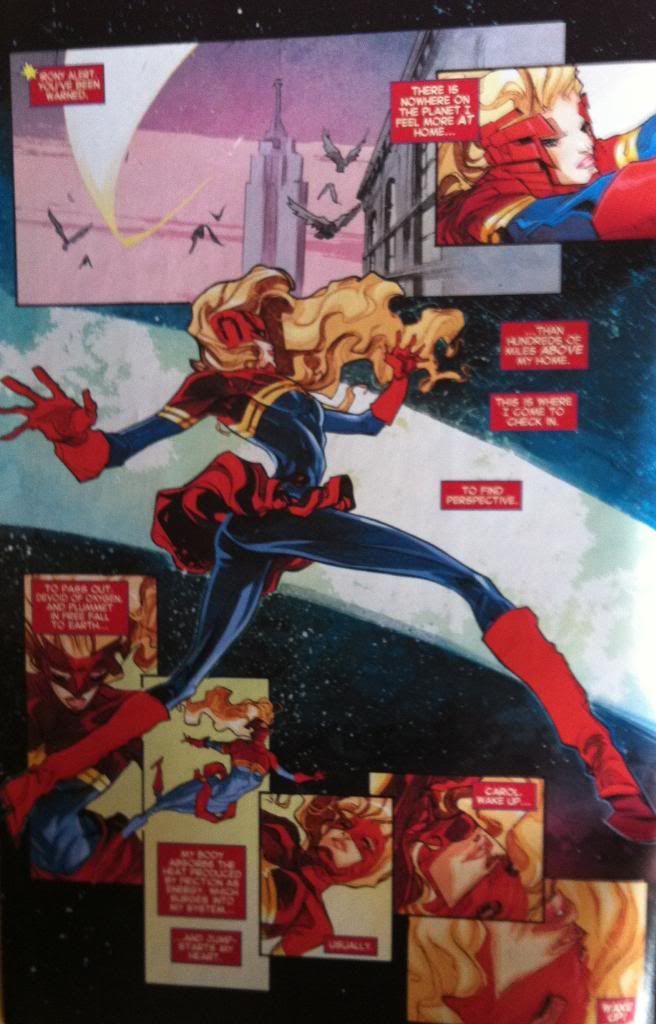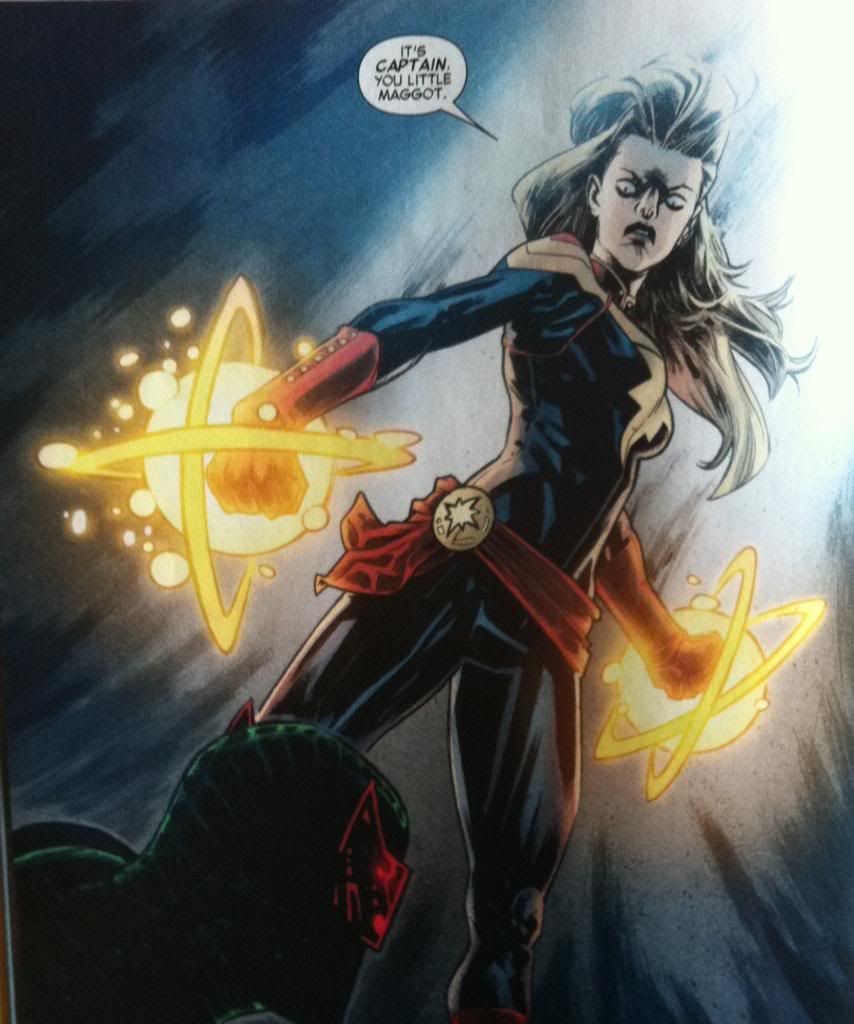(Marvelling at Captain Marvel 13-14, Assembly on Avengers Assemble 16-17, and Examining The Enemy Within 1-shot)
by Kelly Sue DeConnick, Scott Hepburn, Jordie Bellaire, Matteo Buffagni, Gerardo Sandoval, Andy Troy, Nolan Woodward, Pepe Larraz, Matt Wilson, and Clayton Cowles; Marvel Comics
The Enemy Within is the recent Crossover between Avengers Assemble and Captain Marvel. The crossover is mostly the climatic act of the ongoing Captain Marvel storyline that sees Carol Danvers beset by rogues from her past and the machinations of the shadowy Yon-Rog. Problems go from personal to global, and Captain Marvel, with the help of the Avengers, must save the world from an enemy within Carol's past. The entire thing feels substantiative and worthwhile and is an absolute must read for anyone who has been following Captain Marvel.
As much as I hate crossovers, I really enjoyed the Enemy Within. (Crossovers force me to buy additional comics or skip stories, and when I agonize over which comics fit in my budget, having a title forced on me is kind of abrasive.) But The Enemy Within is made of books I was already reading, the entire crossover is written by Kelly Sue DeConnick, the regular writer for both series, and features art that is pretty consistent with both books established looks (Jordie Bellaire's colours being pretty core to the look of Captain Marvel and Scott Hepburn being a good fill in for Filipe Andrade). The crossover also does a good job matching the tones of its constituent comics: the Captain Marvel half is faithful to that books mien with themes of camaraderie and heroism with a female focus built around character and drama, while the Avengers Assemble half fits very well into the Comic-book-as-ACDC-song philosophy and will leave you Thunderstruck by heroes as they Shoot to Thrill, villains as they do Dirty Deeds Done Dirt Cheap, and the action as things progress down The Highway to Hell (Which is to say pretty straightforward action with some really clever, fun, and humorous superheroic goodtimes). Fans of both Captain Marvel and Avengers Assemble should enjoy the crossover.
In many ways The Enemy Within was an ideal crossover for me. But I don't really want to belabour that -I tried and it really ended up being an uninteresting post- and instead would rather focus on one of the neater thematic aspects of the comic I noticed: the way in which the story functions as a commentary on continuity in relation to Captain Marvel.
This post is going to be super *SPOILERS* intensive, so you should read it only when you are up-to-date on Captain Marvel up to issue #14.
The Enemy Within is to a certain extent built around the ongoing narrative of Captain Marvel. The earliest issues of the comic say Captain Marvel sent travelling through time, visiting moments in female aviation and eventually the site of her own origin, the explosion of the Psyche-Magnitron that granted her powers. This was a cool semi-reinterpretation of Carol Danvers origins that tied her to a tradition of female pilots and heroism. However, the time travel, re-exposure to the Psyche-Magnitron blast, and her own alien-hybrid physiology combined to produce a brain lesion that grows whenever she uses her powers. As a result Captain Marvel is under orders not to fly or over exert herself at the risk of exasperating her condition and possibly causing brain damage, erasing her memories and personality. So, in a way The Enemy Within is about Carol fighting for her history and identity, which is, to a certain extent, fighting to maintain her continuity.
Which makes sense. Carol Danvers as a person would obviously not want her mind obliterated. But beyond that, the continuity, the history, of Captain Marvel makes her pretty cool: a superpowered former fighter jock who is a veteran avenger, has ties to alien empires, and is an unrepentant nerd. In my view she is one of the core Avengers, to the point where I think she should be as key a player as Iron Man, Captain America, and Thor. (It's kind of my hope that by the time that Kelly Sue DeConnick is done with Captain Marvel everyone sees her as being as important as I do.) So, in a lot of ways, the things that make Captain Marvel so marvellous, and more than a super powered sexy-lamp, are tied to her history and personality. So it makes sense for Carol as a fictional character to fight for control over the good aspects of her history.
The Enemy Within is also a story built around how Captain Marvel is embattled by her continuity. From a story perspective she is kept grounded by her history: flying and being too amazing comes at the price of wiping out her past. But it goes beyond this. The Enemy Within has Captain Marvel and the Avengers fighting monsters from Carol's past over and over again in a pretty pointed contrast to how Superhero comics often recycle villains and storylines over and over. Moreover, Yon-Rog, a villain present at Carol's superpowered origins, uses a keepsake fragment of the Psyche-Magnitron, another element of Captain Marvel history, to superpower himself. And he uses his new-found power to create a nostalgia-driven mirror version of his homeworld and remake Earth as he would want it. So in a lot of ways The Enemy Within is a story where Carol is literally trying to overcome her past, to defeat a vaguely patriarchal figure yearning for the good-old-days, and to overcome the negative aspects of her continuity.
Again this is a rather pointed observation about the nature of continuity because to a certain extent Carol is also limited by it. To some people Captain Marvel will always be a Miss, a lady-derivative version of a character, himself an object in trademark acquisition, that wears an impractical bathing suit costume. She is a character who has so often been under-utilized as lady set dressing to de-dudify The Avengers. She has also had a lot of considerably shitty things happen to her at the hands of writers: she was raped and impregnated by her own child (kind of), was made into an alcoholic, she had her powers stolen by Rogue, had loved ones killed, was granted amazing cosmic powers just to be stripped of them, was dumped on the shitty side of Civil War, and a lot of other pretty gross things. A lot of profoundly creepy and awful things have happened to Carol Danvers that are probably all better left forgotten and not head canon. So, in many ways, moving Captain Marvel forward as a really fantastic character involves overcoming these less savoury aspects of her past. Which is kind of, in this literallized sense, what Captain Marvel has to do in The Enemy Within.
Which is all a pretty telling commentary on the nature of continuity and history to comic book characters. On the one hand, their history contains a lot of great elements that are key to our love of characters while simultaneously containing a lot of terrible and limiting baggage too. Therefore, there is this tension between the nostalgia of the characters we love and the need to see them move beyond that, to be something new and modern and more than they were. Especially with female characters like Captain Marvel whose histories are doubley complicated by creepy dude writers and the problematic attitudes towards women in the past and present. Moving these characters forward means redefining them to a certain extent and pissing off some people (largely nostalgic Yon-Rogger dudes). Or, to put it differently, to fly and punch through the sky, Captain Marvel has to beat her past and be willing to risk the uncertainty of a future without the certainty of her history and nostalgia, to risk being something new.
Which, when everything is said and done is basically how The Enemy Within ends: Captain Marvel sacrifices herself, flies and pushes beyond the limitations of her medical condition, potentially forfeiting her past and identity to take away the power of Yon-Rog (himself a manifestation of her conitinuity). It's brilliant and courageous and sad and triumphant and leaves us in a place of uncertainty about who Carol is. And I for one, could not be more excited to find out.
(Or at least that's my take on it.)
Previously:
Marvelling At Captain Marvel #12: Demarcating reality and fantasy
Marvelling At Captain Marvel #10: A dramatic contract
Marvelling At Captain Marvel #9: How your brain tells time
Marvelling At Captain Marvel #7: Saving a reporter in distress... AND ITS A MAN!
Marvelling At Captain Marvel #1: An alternate reading order that I liked more
Assembly on Avengers Assemble #9-11: Characterizing relationships







Interesting. I hadn't seen it that way. I enjoyed the whole storyline for the most part, although some of the pacing felt a bit up-and-down and the final issue in particular felt like we needed more panels, but the character stuff I liked. Your interpretation here is something I hadn't even considered! I hope that we get some resolution to the events of this storyline before anything funny happens to the book.
ReplyDeleteThanks. I was trying to write something else and kind of noticed this take on Enemy Within and thought it might be worth talking about (it was certainly more interesting than the other thing...) I'm kind of hoping that DeConnick on Captain Marvel turns into one of those era defining five year run things; something that will carry on to how people look at the character going forward.
DeleteI think some of the up-and-down is that AA and CM are two very different books (focused character drama and Back in Black team hijinks) and keeping both books identities required some atmospheric yaw (maybe?). And yeah, that last issue, I think, showed some deadline crunching (what with it being two books on the eve of Infinity). I mean the creative team absolutely destroyed the key moments, but some parts looked a little rough. Of course, maybe its fun to think about deadline-art issues as evidence of Captain Marvel losing her mind a bit from the brain-thing?
Thanks for commenting!